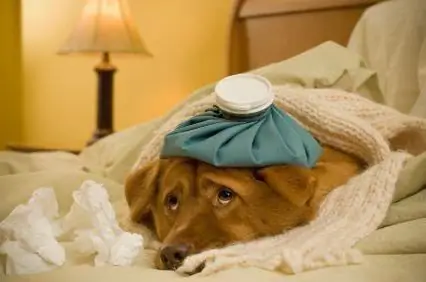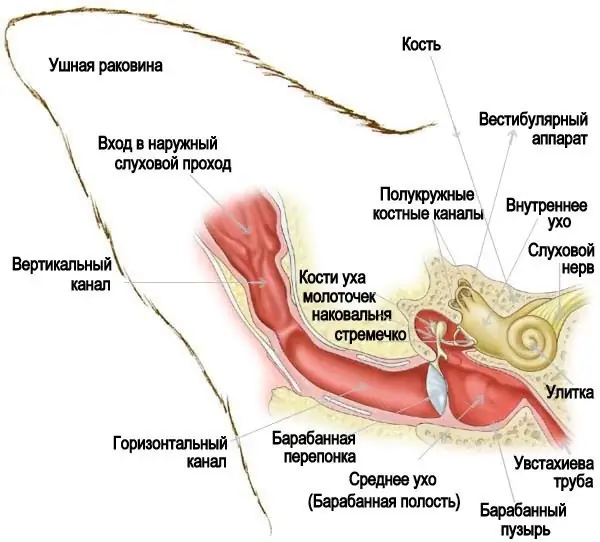2026 Author: Priscilla Miln | [email protected]. Last modified: 2025-01-22 17:55:15
Skin is the most important and largest organ in a dog, the main function of which is a barrier. Violation of the integrity of the skin causes negative consequences for the pet, so you need to carefully monitor its condition and take action in time. One common problem is fungus.
What is fungus?
Fungus in dogs, or dermatophysis, is a common reason for visiting veterinary clinics. This disease can develop in a dog at any age and under any conditions, even under the best conditions. It is almost impossible to protect a pet from the appearance of a fungus, but it can be cured. Today, there are many modern drugs that can successfully fight the disease. The main thing is to recognize the occurrence of a problem in time and seek help.
There are many varieties of fungus, but only a few of them are dangerous for a pet.

How does fungus appear?
Fungus in dogs can appear in the course of communication with individuals already suffering from this disease. After walking on polluted grass alsothere is a high risk of infection. However, the fungus can be brought from the street by the owner himself on the shoes. These microorganisms are quite dangerous. Some of them can harm not only the animal, but also the person.
Another case is a dog's low immunity or high susceptibility to disease. A yeast fungus is always present on the skin of dogs, which does not cause any diseases. Under certain conditions, the number of bacteria begins to increase, resulting in Malassezia.
Puppies, young dogs, weak animals after illness, animals prone to allergies and with immune pathologies are susceptible to the fungus.
Dermatophysis is a common occurrence in dogs with tangles and hairballs. The skin does not breathe well under them, as a result of which its protective function is reduced. Also, if the dog is washed excessively with cleansing shampoos, the skin loses its functions, and again, a fungus in dogs can develop. Therefore, you should not bathe your pet often, even if it seems to you that the coat already looks dirty.
The rate of reproduction of the fungus is very high, so at the slightest suspicion of its presence, you should immediately go to the clinic.

During the process of reproduction of the microorganism, the dog's immunity is reduced, even though vaccinations have been made. Dermatophysis affects the deep skin layers, which leads to inflammation of the follicles. And this creates the most favorable environment for the subsequent emergence of other parasites.
Where does fungus occur in dogs?
As a rule, the onset of the disease hasa certain scheme. At first, a fungus appears on the dog's paws and ears.
Sometimes it appears only on the interdigital area, on the skin around the claws and paw pads. The skin becomes rough, inflamed and cracked, crusts or scales appear, the nails turn yellow and begin to bend.
Fungus in dogs on the paws most often occurs in the autumn and spring periods. The pet begins to limp, gnaw on the affected areas. A fungus may also appear in the ear of a dog, on the inner surface without hair. Since in these places the hairline is sparse, it is easiest to notice the disease there. Ear fungus in dogs is dangerous, because with severe itching, the pet will actively scratch the area and can damage the auricle.
Symptoms of disease
Like any disease, fungus in dogs has its own symptoms. The primary symptom by which you can determine the presence of infection is itching. It will not be difficult to recognize this moment, since any owner will immediately notice when his pet begins to itch often. In places where itching occurs, peeling of the skin forms.
Infection with trichophytosis is also possible, while rounded bald patches form on the dog's skin. Purulent discharge may appear, resulting in the formation of crusts. This fungus infects the hair follicles. In the future, they may not fully recover, and the stains will remain forever.

Dogs are prone to infection with a fungus such as favus. The parts of the body affected by it emit an unpleasant odor. Rounded skin appearsspots with crusts of a gray-yellow hue. After getting rid of the infection, the hair there may also not recover.
There are cases when the fungus of the skin goes to the follicles, and then a chronic form of the disease develops. A pet with chronic mycosis can infect animals and people.
Who is affected?
Fungus occurs, as a rule, in young dogs, because their immunity is not yet strong enough. Poor nutrition, hormonal imbalance and corticosteroid therapy also affect the development of the disease.
The incubation period of the disease is 8-30 days. It is impossible to determine the type of disease and methods of treatment on your own, so you should not take any measures without consulting a doctor.
At the vet's appointment
The veterinarian will conduct a comprehensive examination of the pet, if necessary, prescribe other diagnostic methods, for example, a study using a lamp, microscopy. Only after a fungus is detected in a dog, treatment can be carried out.
The development of mycosis is promoted by a high level of humidity, because the microorganism actively reproduces in heat and in the light. Veterinarians recommend, based on this, not to walk the pet during the day.
Fungus without symptoms
It happens that there are no symptoms at all, but the fungus is present. You can notice how the hairs periodically crumble, and if the infection occurred a long time ago, then the hair becomes dull, starts to get confused and looks unpresentable after just a few days after washing. Many write offthese processes are for molting - seasonal, from a change in feed or shampoo. However, the coat will remain in this state until action is taken. Sometimes you can see small bald spots of slightly gray skin, but if the pet has a long coat, it is almost impossible to detect them.

This can happen for various reasons. Perhaps the pet has a good resistance to the disease or the pathogen is not very dangerous. But in any case, having discovered such symptoms, it is necessary to take a skin scraping to make sure that the amount of the fungus does not exceed the norm.
How to cure fungus in a dog? It all starts with a diagnosis
The veterinarian will illuminate the coat with a lamp. If the fungus is present, then an emerald color will be visible. But it is worth taking into account the fact that half of the existing fungi do not give such a glow.
Diagnosing with a lamp gives absolutely no information, except for the belief in the presence of a fungus.
If the veterinarian immediately prescribes all kinds of pills and ointments, without conducting other tests, then the disease can be fought for many years. Therefore, you need to either insist on continuing the diagnosis, or go to another doctor.
A comprehensive analysis is needed to determine the type of fungus, the number of bacteria, their rate of reproduction, sensitivity to drugs. This is not exactly a cheap service.
How to detect fungus?
You can identify skin fungus in dogs using the following tests:
- Blood donation for bacteriology. May besuch that the pet is sensitive to cocci and other bacteria, and the fungus itself is a secondary infection. In this case, you need to eliminate the source of the disease.
- Donating blood to determine allergic reactions. Allergies may not always manifest themselves and have pronounced symptoms. If the inflammation of the pet's skin is due to allergies, then the fungus will appear all the time, even after seemingly successful treatment. First of all, you need to eliminate the allergen.
- Donating blood and urine for a detailed biochemical analysis. It is important to find out the state of he alth of the pet, since the fungus in the dog appears precisely at the time of weakened immunity or against the background of chronic ailments. Analyzes will show whether there are malfunctions in the work of any organs.

Having the results of the tests in hand, the veterinarian will instantly be able to determine how to treat the fungus in the dog. It is important to choose exactly those drugs that will not only weaken the microorganism, but destroy it.
Preparations to fight the fungus
If there are only a few spots with bald patches on the dog's skin, then ointments and solutions are applied:
- "Clotrimazole".
- "Yuglon".
- "Mycosolone".
If the affected areas are large, then the use of such agents is dangerous, since antifungal drugs are toxic. In this case, use shampoos:
- "Fluconazole".
- "Griseofulvin".
- "Ketoconazole".
They also use drugs intablets or injections in combination with immunostimulants.
There are times when an allergic reaction appears at the injection site. To prevent this from happening, the dog can additionally be given Diphenhydramine.
To eliminate the fungus in a dog, treatment is prescribed with antifungal antibiotics, however, they can cause disruption of the digestive tract and liver.

Be sure to check with the doctor if this type of fungus is transmitted to other animals and humans. If the answer is positive, gloves should be worn during treatment of the pet. It is best to isolate the dog for a while, for this you can use a separate room or aviary. But the pet should not feel abandoned, as stressful situations reduce immunity.
Self-treatment - aggravation of the situation
If someone you know gives you advice on how to get rid of the fungus on your own, or shares doctor's advice, you should not use them. Each case is individual, and in order not to harm the pet, you should not self-medicate. Since a fungus often occurs in a dog, it is not difficult to find photos of diseases as well as methods of treatment. Many, believing that this is not such a serious illness, begin to seek information and conduct treatment on their own. But this should not be done. Not only can you spend a lot of money on unnecessary drugs, you can also aggravate the situation and harm the he alth of the animal.
As soon as a fungus is found in a dog, it is worth throwing out all the bedding, disinfecting toys and othersobjects that the dog has come into contact with. Replace combs and brushes with new ones.
Disease prevention
Fungus prevention is about maintaining hygiene and maintaining the dog's immunity. It is worth refraining from walking a pet in places where stray dogs walk. It is also necessary to observe the correct diet and give the animal sufficient physical activity. Be sure to buy vitamins for your pet to increase immunity.
Vaccination against the fungus is ineffective, and sometimes it worsens the situation. It is impossible to protect a pet from infection, however, having noticed the disease in time, you can contact a veterinarian and destroy the infection.
If you have absolutely no way to visit the vet, you can make your own antifungal ointment. This requires natural birch tar, sulfuric ointment and acetylsalicylic acid. We take 25 g of ointment, 2 tablets of acid and 1 tsp. fly in the ointment. Then we mix everything well. This medicine is considered an analogue of the Yam ointment, only it will cost several times cheaper.

A dog is a man's friend, and if you decide to take responsibility for keeping an animal, then you need to understand that any pet needs proper care, nutrition, attention and treatment. After all, every animal is prone to various diseases for one reason or another. Regularly referring to a doctor, you can identify ailments at an early stage of their development. Do a home check on your dog daily as there are many infections that a pet can pick up onstreet.
Recommended:
Cirrhosis of the liver in dogs: symptoms and treatment, life prognosis

It would seem that cirrhosis of the liver is a completely human disease that occurs most often with the abuse of alcohol and fatty junk food. But our smaller brothers - cats and dogs - also suffer from this disease. So, cirrhosis of the liver in dogs, symptoms and treatment, as well as diagnosis and causes of occurrence - we will consider all this in this article
Food for dogs of large and small breeds. Complete nutrition for dogs. Meat for dogs

In order for a beautiful he althy dog to grow out of a small puppy, you need to choose the right, well-balanced diet for him. After reading today's article, you will learn how to feed a shepherd dog and what to give a miniature lapdog
Cushing's syndrome in dogs: symptoms and treatment. Cushing's syndrome in dogs: how long do they live?

Today we want to talk about a serious endocrine disease that is common in dogs, and it is called Cushing's syndrome. How to recognize its symptoms, undergo the correct diagnosis and treatment? Answers to these and other questions in our article
Otitis in dogs: treatment with antibiotics and folk remedies. Types and symptoms of otitis media in dogs

Otitis is an inflammation of the ear, which gives a lot of discomfort not only to people, but also to our smaller brothers. It is worth noting that animals are much more likely to suffer from such an ailment. If, after cleaning your pet's ears, you notice that the dog's ears are dirty again the next day, she constantly scratches them and shakes her head, and the secretion secreted smells unpleasant, then you should immediately visit a veterinarian
Treatment of nail fungus during pregnancy: a review of drugs. Can nail fungus affect pregnancy?

The use of drugs by a pregnant woman without the advice of a doctor can lead to very disastrous results. In addition, during pregnancy, you need to carefully monitor any changes that occur in the body. If there is a suspicion that there is a fungus on the nails, then you should immediately seek advice from the hospital, it is better treated in the early stages

